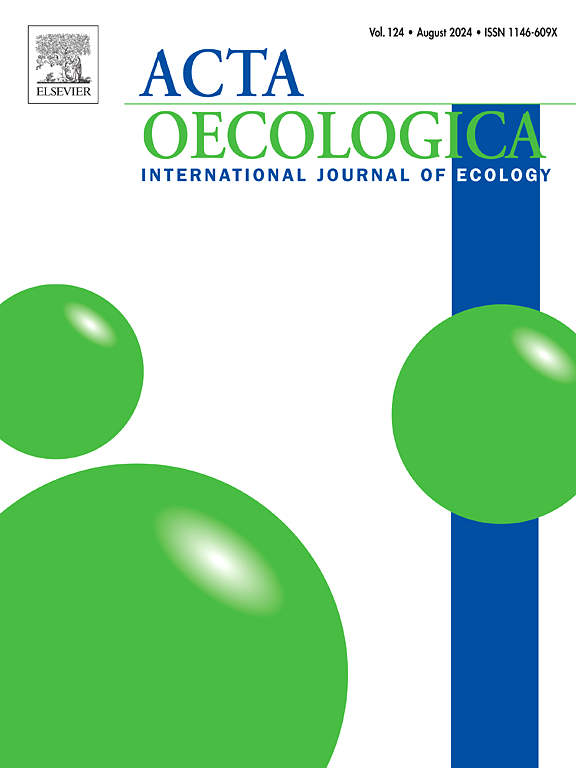城市化增加了大西洋森林残片的初级生产总量和生物量
IF 1.3
4区 环境科学与生态学
Q3 ECOLOGY
Acta Oecologica-International Journal of Ecology
Pub Date : 2025-09-21
DOI:10.1016/j.actao.2025.104126
引用次数: 0
摘要
城市化对濒危大西洋森林生物量生产和储存的影响需要进一步调查,寻求监测碳通量的有效方法。本研究比较了巴西大西洋森林城市森林和非城市森林不同季节的总初级生产量(GPP)和植被生物量增量。我们假设城市森林和雨季(春季和夏季)的GPP和生物量值分别高于非城市森林和旱季(秋季和冬季)。本研究使用两种MODIS产品,分别提供GPP和净初级生产量(NPP),对2004年至2024年间巴西蒂茹卡国家公园(里约热内卢de Janeiro, Brazil)的城市森林和同等规模和气候区域的非城市森林的光合活性和生物量进行了量化。20年来,雨季GPP和生物量(GPP = 9.5±1.6 g C m−2 day−1,生物量= 12.3±2.2 g C m−2 day−1)均高于旱季(GPP = 7.4±1.2 g C m−2 day−1,生物量= 9.6±1.6 g C m−2 day−1)。城市化和雨季共同正向影响GPP和生物量的增加,表明城市化和降雨对生产动态具有协同效应。研究结果表明,降雨和城市化对大西洋森林破碎片的初级生产具有正向影响。这些因素在减少碳排放和加强生态系统服务方面发挥着重要作用,尤其是在快速城市化和气候变化的背景下。本文章由计算机程序翻译,如有差异,请以英文原文为准。
Urbanization increases gross primary production and biomass of Atlantic forest fragments
Urbanization impacts on biomass production and storage in the endangered Atlantic Forest require further investigation seeking effective methods for monitoring carbon flux. Our study compared gross primary production (GPP) and vegetation biomass increment across seasons between urban and non-urban forests of the Brazilian Atlantic Forest. We hypothesized higher GPP and biomass values in the urban forest and during the rainy seasons (spring and summer) compared to the non-urban forest and dry seasons (autumn and winter), respectively. We used two MODIS products which provides GPP and net primary production (NPP) to quantify the photosynthetic activity and biomass of an urban forest in Tijuca National Park (Rio de Janeiro, Brazil) and a non-urban forest of comparable size and climate region between the years 2004 and 2024. We observed higher values of GPP and biomass in the rainy seasons (GPP = 9.5 ± 1.6 g C m−2 day−1; biomass = 12.3 ± 2.2 g C m−2 day−1) compared to the dry seasons (GPP = 7.4 ± 1.2 g C m−2 day−1; biomass = 9.6 ± 1.6 g C m−2 day−1) in the 20 years. Urbanization and rainy seasons together positively influenced GPP and biomass increase, indicating a synergistic effect of urbanization and rainfall on the production dynamics. We concluded that the primary production of the Atlantic Forest fragments examined was positively influenced by rainfall and urbanization. These factors serve as significant agents in mitigating carbon emissions and enhancing ecosystem services, especially amidst rapid urbanization and climatic changes.
求助全文
通过发布文献求助,成功后即可免费获取论文全文。
去求助
来源期刊
CiteScore
3.60
自引率
0.00%
发文量
57
审稿时长
>0 weeks
期刊介绍:
Acta Oecologica is venue for the publication of original research articles in ecology. We encourage studies in all areas of ecology, including ecosystem ecology, community ecology, population ecology, conservation ecology and evolutionary ecology. There is no bias with respect to taxon, biome or geographic area. Both theoretical and empirical papers are welcome, but combinations are particularly sought. Priority is given to papers based on explicitly stated hypotheses. Acta Oecologica also accepts review papers.

 求助内容:
求助内容: 应助结果提醒方式:
应助结果提醒方式:


